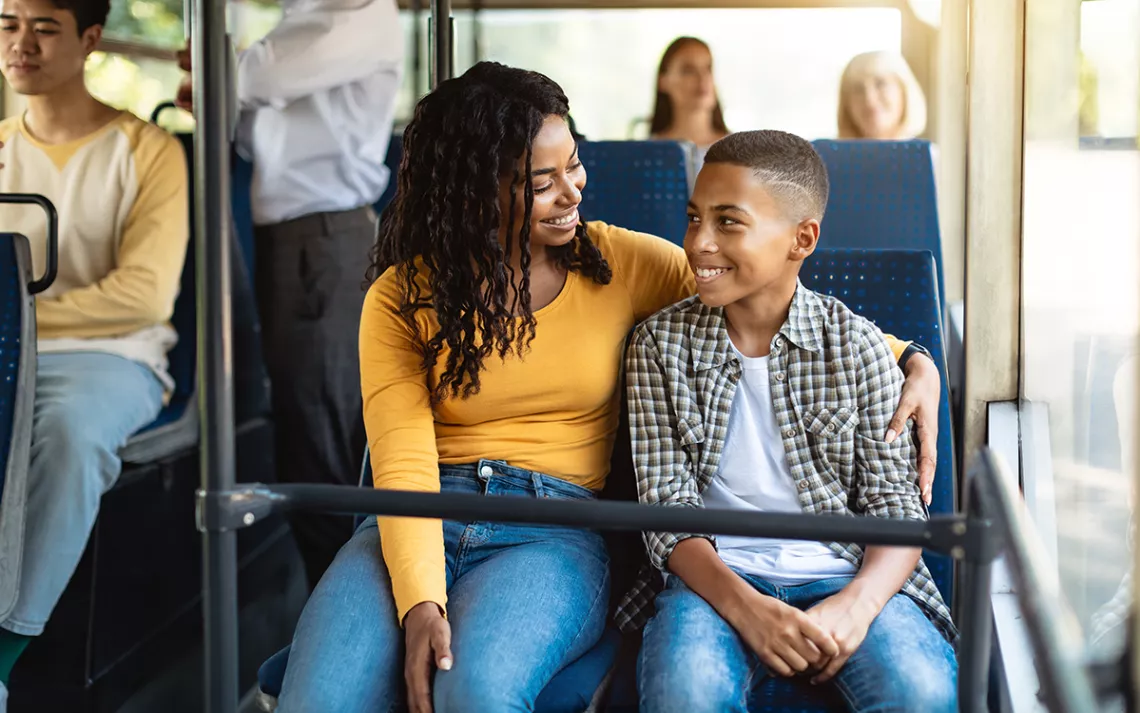4 Fun Ways to Observe Transit Equity Day
Rosa Parks’s birthday has evolved into an intersectional celebration of climate, labor, and social justice causes

Photo by Prostock-Studio/iStock
In December 1955, a 42-year-old African American civil rights activist took a seat in the front of the bus on her ride home from the Montgomery, Alabama, department store where she worked as a seamstress. When the bus driver commanded her to move back—as the front 10 seats were permanently reserved for white passengers—Rosa Parks refused. Her subsequent arrest quietly set off a social revolution.
Today—which would have been Parks’s 110th birthday—marks the sixth annual Transit Equity Day, a celebration of the civil rights icon’s role in advancing a more just and equitable public transportation system for all Americans. The brainchild of labor leaders, advocates for public transit and social justice, and greens across the country, the day highlights the need for and benefits of a reliable, accessible, safe, and climate-resilient transportation system. Last year, US Transportation Secretary Pete Buttigieg publicly commemorated Transit Equity Day, cautioning that poor transportation policies could “reinforce racial and economic inequality by dividing or isolating neighborhoods.”
Taking a cue from the Labor Network for Sustainability (LNS), the Sierra Club is part of a wide network of partners making specific demands of local transit agencies—including better pay for workers, electrification of bus fleets, and funding for free transit passes. “Transit Equity Day isn’t just a day of action,” says Bakari Height, LNS organizer and Transit Equity Day project manager. “This day passes the torch from civil rights leaders like Rosa Parks and Claudette Colvin to the current labor and environmental justice leaders, and all of the tireless and dedicated transit advocates and labor unions who recognize the need to make this massive mode shift a reality by calling on leaders to change transit inequities.”
Transportation also happens to be the leading source of climate pollution in the US. “It’s a day of education and organizing, to uplift the year-round work of people mobilizing in their communities for more connected and less polluting bus networks—at the intersection of racial equality, climate justice, and labor,” says Katherine Garcia, director of the Sierra Club’s Clean Transportation for All program.
“People of color shouldn't worry if they will make it to work on time due to inadequate transit,” says the Sierra Club’s Black Action Team. “If a low-wage worker has a long commute to and from their job on public transportation, they shouldn’t have to spend too much money to get to work while inhaling harmful fuels.”
Beyond checking out Transit Equity Day events across the country (think group rides, film screenings, rallies, and public dialogues), RSVPing to LNS’s transit activism livestream, and posting your appreciation of public transit with the hashtag #TransitEquityDay, here are four unique ways to lift up this important occasion.
1. Visit a city to savor its free public transit.
In 2020, The New York Times estimated that 100 cities around the world offered free public transit. Many of them are in Europe, but the trend is taking off in the US too. In 2019, Kansas City, Missouri, became the first major US city to implement a universal Zero Fare Transit program, a top priority for Mayor Quinton Lucas, who reasoned that better access to employment and education opportunities would lead to a healthier community. Smaller cities, including Olympia, Washington, and Corvallis, Oregon, already have successful fare-free programs.
As COVID-weary municipal leaders try to entice people and businesses back to urban centers, the push for free buses and trains—long heralded in progressive circles as a way to mitigate carbon emissions and bridge socioeconomic disparities—is gaining steam. On her first day in office last year, Boston mayor Michelle Wu filed an order to eliminate fares for two years on bus lines traversing some of the city’s most economically disadvantaged neighborhoods. And following the ridership boom and air quality gains resulting from the Utah Transit Authority’s “Free Fare February” pilot program in Salt Lake City last year, Governor Spencer Cox is calling for a fare-free year. Last year in Colorado, 31 transit agencies across the state, including RTD in Denver, experimented with eliminating fares, and this summer, Washington, DC, will offer permanent free bus rides to all residents. (DC is also adding a dozen 24-hour bus lines and investing millions into service improvements.)
2. Find your way to the great outdoors via public transit.
Did you know that in the 1800s, rail barons ran special trains to newly established national parks like Yellowstone and lobbied for new parks—such as at the Grand Canyon—to be created where they’d be accessible to rail lines? These days there’s a new movement underway to restore the mass transit link to nature. The proposed Transit to Trails Act would direct the US Department of Transportation to award grants for projects that increase access to public lands, waters, parks, and monuments for “park-poor” communities.
Separately, so-called Transit to Trails legislation has taken off at the municipal level—in LA, for instance, the Nature for All coalition (which includes the Sierra Club) is working to extend bus routes to parks and trails in the San Gabriel Mountains. Senior organizer Roberto Morales has worked with the Forest Service and various transportation systems; he says the biggest barrier he sees to folks getting out is transportation. “Most rail lines are designed to get affluent folks to work; they don't prioritize low-income communities or outdoor access,” he told Sierra. “It’s something communities have to be loud about—getting local elected officials to understand the need.”
Outside recently reported on ways to explore eight national parks without a car, and in 2017 Sierra’s science editor Heather Smith revealed creative pro tips for getting to other stunning public lands via public transit. Unfortunately, routes can be ephemeral—so when you find a great way to get yourself out into nature, be sure to use it, publicize it, and be ready to fight to keep it!
3. Experience transit equity history.
Learn more about the Montgomery Bus Boycott and Rosa Parks as well as lesser-known, 15-year-old activist Claudette Colvin (she was arrested in 1955 for refusing to give up her seat to a white woman, nine months before Parks’s more widely known action) by visiting the Birmingham Civil Rights National Monument in Alabama, or perusing its website. Established in 2017 by President Obama, the site preserves four historically charged city blocks—including the site of the 16th Street Baptist Church and the Birmingham Civil Rights Institute.
Another piece of transit-equity civil rights history is the Freedom Riders National Monument in Anniston, Alabama, which celebrates the interracial Freedom Riders, who in 1961 challenged discriminatory laws requiring separation of the races in all interstate travel. The Freedom Riders boarded integrated buses and were attacked by firebombing segregationists—images of which shocked Americans and spurred leaders to end segregated travel policies.
4. Take a cue from electrified communities and fight for public e-fleets and charging infrastructure.
Climate/transit advocates are energized by the recently passed Inflation Reduction Act, which includes $370 billion in climate investments to decarbonize the power and transportation sectors. Beyond incentives for individuals to buy EVs and tax credits for investment in domestic fuel-cell production and industries that use zero-emission commercial trucks, an additional billion dollars provides funding for zero-emission school and public transit buses. President Biden’s recently released blueprint to decarbonize the US transportation sector calls for net-zero carbon emissions by 2050, promising good-paying jobs, better air quality, and lower transportation costs for Americans.
Los Angeles, which has the second-largest bus fleet in the nation, plans to convert all of its 2,300 buses to electric by 2028. San Francisco plans to have its 1,100 municipal buses all-electric by 2035. And New York City’s 5,700 buses, the biggest fleet in the nation, will be all-electric by 2040. Plenty of smaller and redder communities have made the pledge as well.
If your local elected officials try to tell you that electric school buses and/or public transit isn’t feasible, point them at this diverse list of places across the US—with varying climates and densities, not to mention various types of electric utilities—that have successfully electrified their transit sectors. Not sure where your region stands? Here’s a handy tool to find out how many electric buses are serving your area.
 The Magazine of The Sierra Club
The Magazine of The Sierra Club
